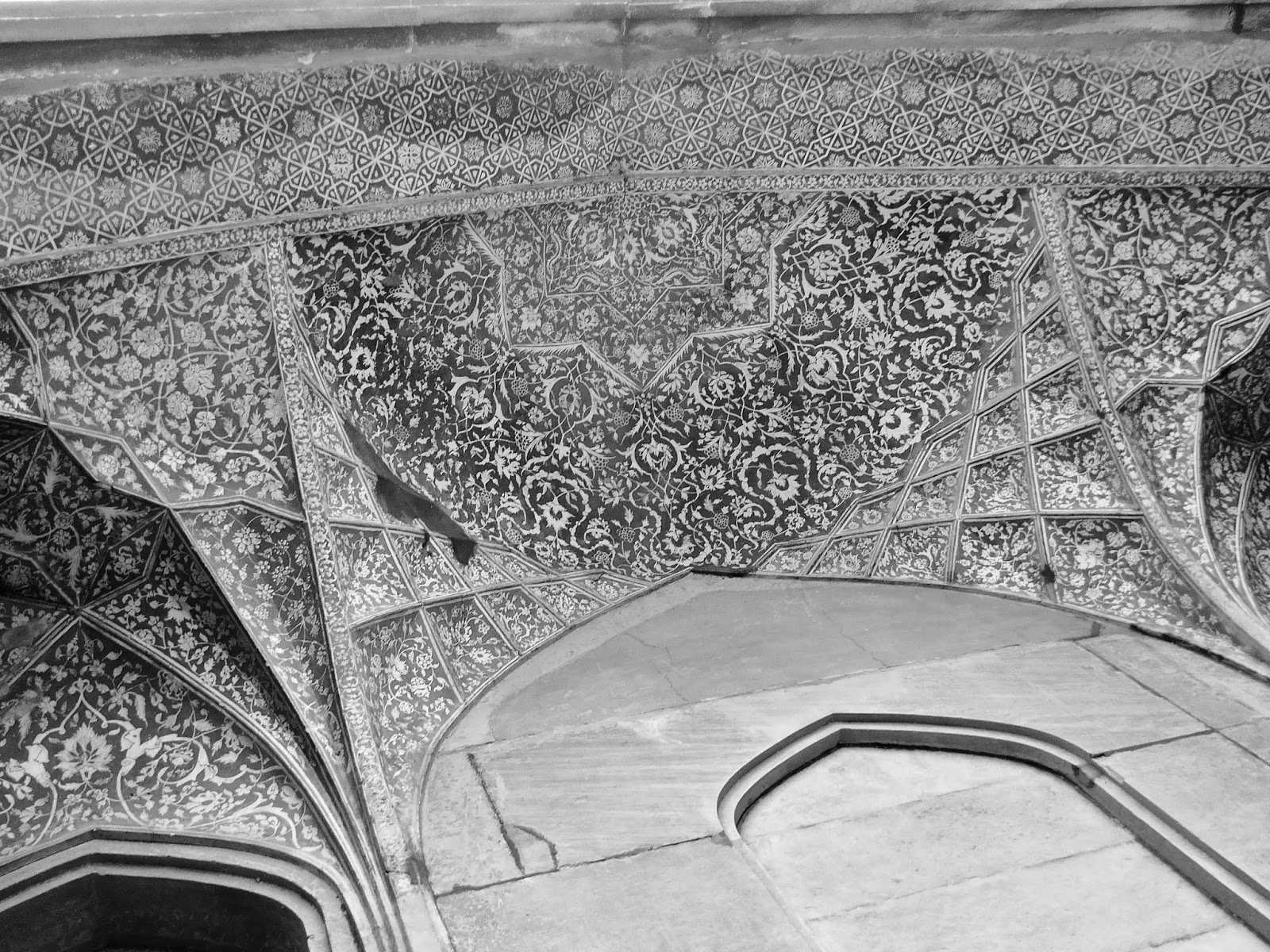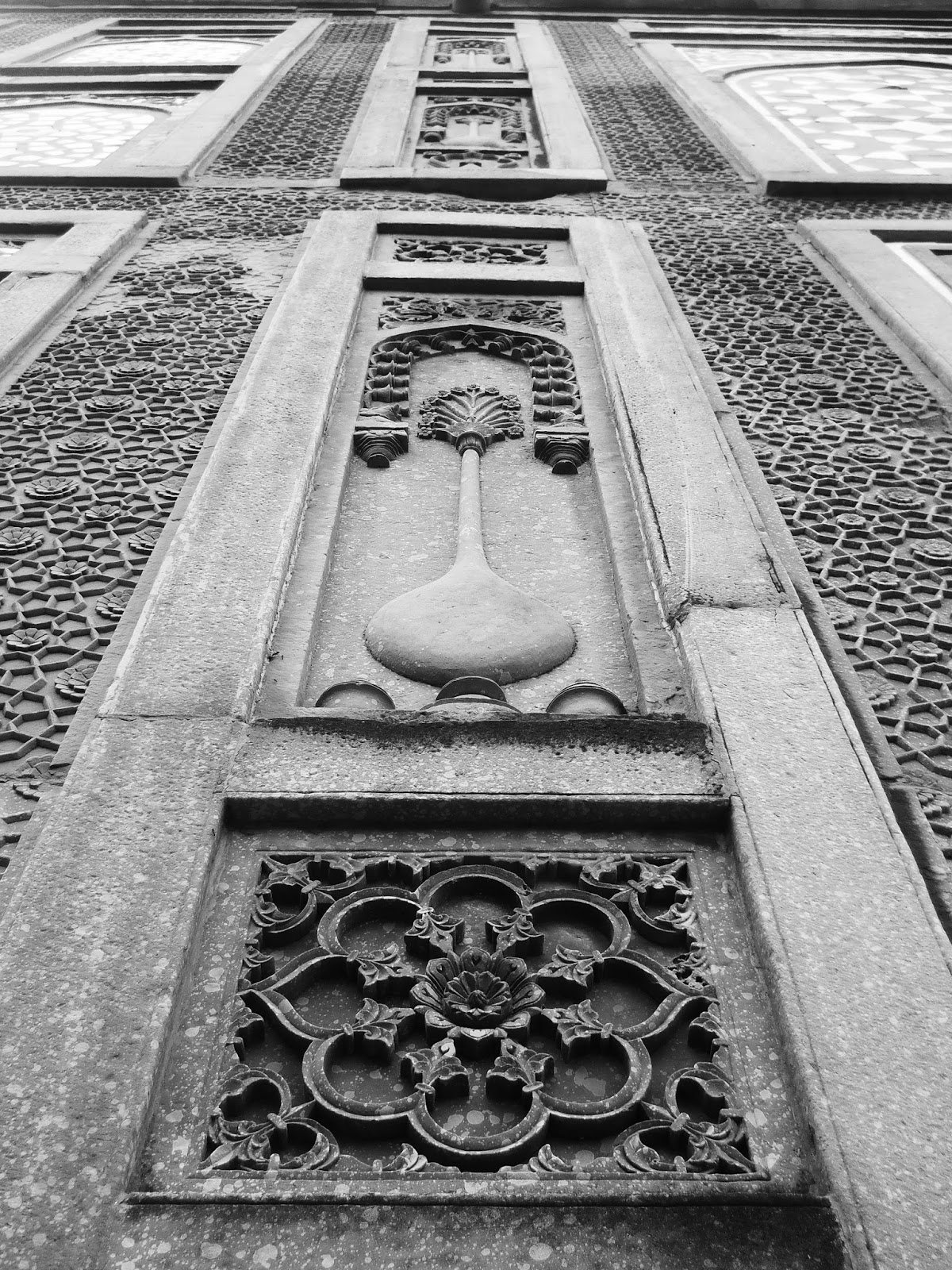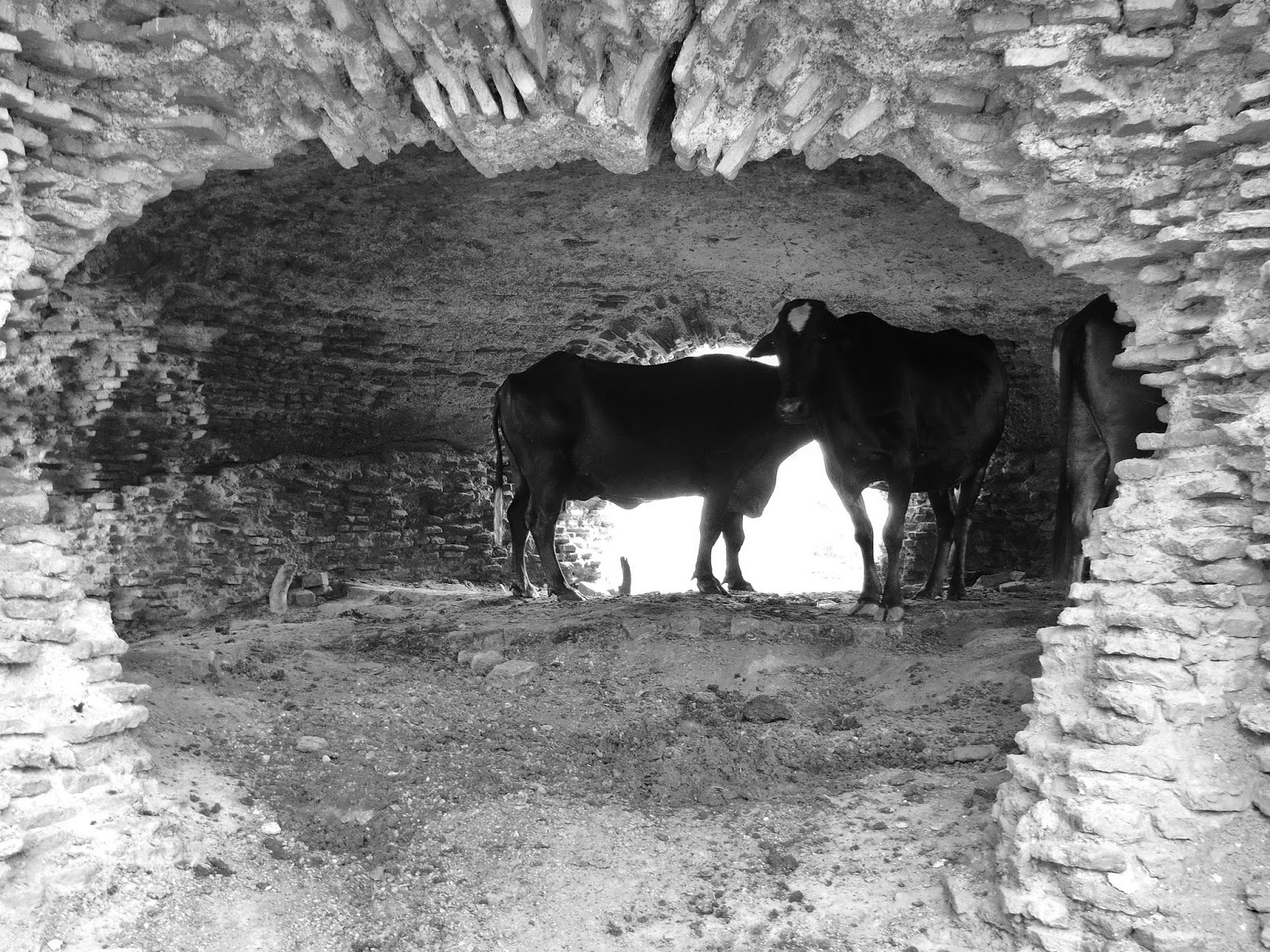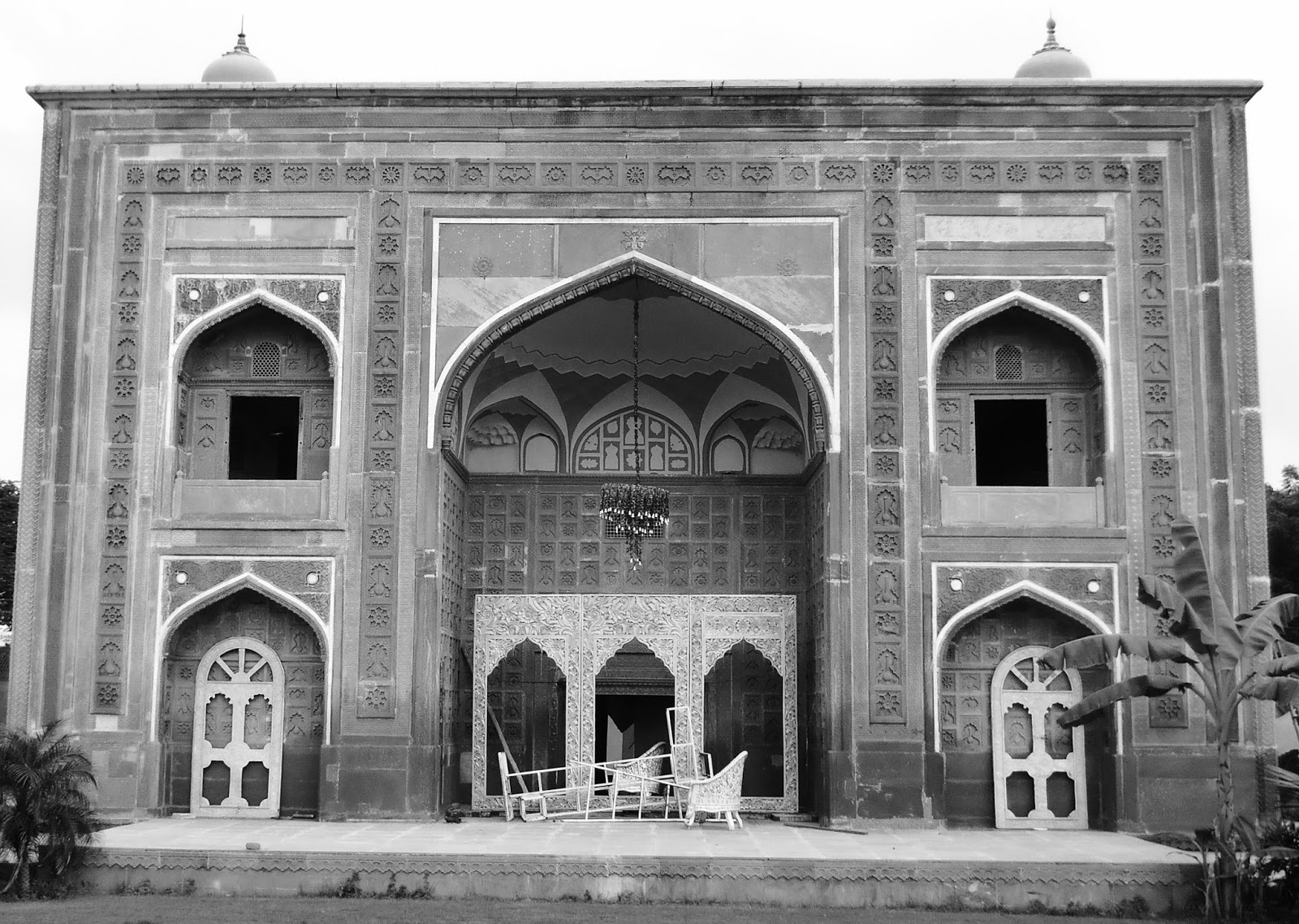Truly excellent carvings on the side of one of the false gateways to the tomb of the Mughal emperor Akbar. The carvings say a great deal about the man, as they show that he did not adhere to a strict interpretation of Islam, which forbids any sort of art depicting humans or animals. It's rather a shame that by Shah-Jahan's time the Mughals had shifted away from incorporating carvings of living things other than plants into their buildings. The quality of the craftsmanship here is extremely high, as it is throughout Akbar's tomb complex. It's interesting to speculate where Akbar's style of architecture would have gone had it outlived him.
Sikandra is an area about 10km West of the Taj Mahal. It's assumed that the name comes from Sikander Lodi of the Delhi Sultanate, who moved his capitol from Delhi to Agra in the 16th century. Why his name was applied to this particular patch of ground, is unclear, as his stronghold was most probably at the location of today's Agra Fort, while there are no Lodi era remains in the immediate vicinity (though the dates of some of the buildings in the area are a matter of controversy).
When one visits Sikandra, what one is almost certainly going to see is the mausoleum of Akbar the Great, which is one of the subcontinent's greatest and most awe inspiring tomb complexes. Yet, oddly, it is not especially well known. This is due to its being close to the Taj, but not quite close enough for people visiting the Taj to take the time to come out and see it. But while the Taj may be the more perfect tomb, Akbar's mausoleum is in a way the more interesting. It's architecture is vastly more eclectic and unusual, making the mausoleum unlike any other tomb in Agra. It also includes four massive and spectacularly decorated "gates." Only one, that on the south side of the square tomb enclosure, actually allowed people in and out of the complex, while the other three, rather like the Mehmankhana of the Taj Mahal complex, served as guesthouses and to make a more satisfying composition. Each of these "gates" are monumental in their own right, and are all very different from one another and worth investigating.
The drawback of Akbar's Tomb is that, like all too many of the major monuments in Agra, a large part of it is closed off. If this weren't the case, I think I would like it as a place to visit as much as the Taj Mahal. Yet there is still plenty to see, and the fact that so many tourists exclude it from their itineraries is a shame. Even if not for its merits as architecture, the site is important for the man who's buried there, who in the historical scheme of things was far more influential than Shah Jahan or Mumtaz Mahal.
Scattered around outside of the tomb complex are a number of old buildings, from the early Mughal period onward, in highly variable states of repair. They are all obscure, and some of them are in the process of being rapidly digested by the modern world. A few are now in the midst of construction sites, in locations which make it doubtful that they will remain in existence much longer.
I had the bad luck of visiting the area in the very worst lighting possible. I went at dawn, hoping for strong directional lighting that would emphasize the red sandstone that the monuments are largely composed of, but it was overcast that day, and I didn't have the time to go again. The color in my photographs was mostly sort of washed out and dreary looking, so I decided to get rid of he color entirely on most of these. It would be nice to go again sometime and see the buildings as they were meant to be seen: In blazing sunlight....hopefully I'll get the chance. I will be leading people here on trips I'm running later this year, so who knows....
Not a Mughal building. A colonial church south of Akbar's Tomb, at about 6:30 in the morning.
Mariam's Tomb. This is the mausoleum of one of Akbar's wives, Mariam al-Zamani, who gave birth to the next Mughal emperor, Jehangir, who built the tomb. Mariam al-Zamani, who's original name was Heer Kunwari, was born a Hindu, and was the daughter of the Rajput ruler of Amber. Her title, which was bestowed on her after she gave birth to Jehangir, means "Mary of the Age." She was evidently Akbar's favorite wife (and the only one to have been buried within close proximity of him). She exercised a great deal of influence at Akbar's court, and remained a Hindu, leading many to suspect that she played a major part in Akbar's religious tolerance. She was played by Aishwarya Rai in the 2008 film Jodhaa Akbar, opposite Hrithik Roshan, though the name Jodhaa is a misnomer that was given to Mariam al-Zamani in the 18th or 19th century. The history of the tomb itself is somewhat controversial. Most sources, including the A.S.I. website, say that it was originally a Lodi building that was converted by the Mughals into a tomb, though Lucy Peck in her Agra: The Architectural Heritage disputes this, and asserts that it was entirely built during the Mughal era.
Mariam's grave, in a crypt under the tomb, lit by a small LED flashlight.
Small Tomb outside of Akbar's mausoleum complex. Like that of Mariam's Tomb, the history of this building is unclear. It is not known who is buried here, and while some sources say it dates from the Lodi period, others assert it was an early Mughal construction. The only really certain thing about it is that it comes from a somewhat earlier point in history than the majority of the buildings nearby.
The splendid Kanch Mahal, just outside of Akbar's Tomb enclosure. Here, judging by the decoration, it's obvious that the building dates from around the same time as those in Akbar's tomb enclosure. The purpose of the building, however, is a matter of debate. It's said either to be a palace for members of Akbar's harem, or, again according to Lucy Peck, some sort of gateway.
A view centering on one of the projecting balconies of the Kanch Mahal. Notice the two elephants in the shadows under the balcony. The the windows of the balcony are made of stone carved so finely as to become a transparent screen, in what is known as jali work. Lucy Peck bases her claim that the building is a gate on the fact that only the north facing side of the structure is decorated, while the south side is left plain. While this is an odd detail, there doesn't seem to be any indication of what it would be a gate too...It's fairly incredible how much confusion exists over these monuments. It makes you wonder whether anyone really knows anything at all about anything....
The southern gateway to Akbar's Tomb, which is, along with the tomb itself, one of Agra's greatest buildings. The tops of the four minarets were restored, having at one time fallen down either because of an earthquake or from being used as target practice for cannons. The first time I visited Agra, I remember seeing this gateway from the windows of a tour bus and feeling sad that we weren't stopping here. It wasn't until my fourth trip that I got the chance.
Closer on the gate. Note the two fellows to the left of the opening for scale. The flowers and designs on the gate are not paintings, but inlaid stones. The fitted stonework here is some of the most impressive in Agra, and makes a very interesting contrast to that of the Taj Mahal. Here, while the technique is simpler, the effect is less restrained and in a way more spectacular.
Looking up at a corner of the south gate. Note the two swastikas. No, Akbar was not a Nazi. The Swastika is a sign of good luck in various Indian religions, and its presence on Akbar's nominally Islamic mausoleum is a testament to the man's religious syncretism.
Inlaid stonework on the south gate. This is one of the few pictures that worked reasonably well in color, though I had to turn the contrast up as high as it would go.
The north facing side of the South Gate.
Sgraffito decorations on the inside of the arches of the southern gateway. Sgraffito is a process where two different colored layers are applied to a surface, and then patterns are scratched out of the upper layer, exposing the lower. The very intricate decorations here contrast sharply with the inlaid stonework on the outside of the building.
A column of simple, yet very striking, inlaid stonework, in a pattern that looks almost tribal.
Akbar's mausoleum, from a distance. One of Agra's most unusual monuments, the design of the tomb, rather than being focused around the classic dome of most mausoleums of the period, is instead a series of five platforms that get steadily smaller the higher they go. Akbar's body is buried in a chamber underneath the building, though his main cenotaph is on top of the uppermost platform. The construction of the mausoleum seems to have been planned out and started in Akbar's lifetime, though finished during his son Jehangir's rule. The building is very impressive when viewed from a distance, though one is not allowed to go up onto the platforms. This is a huge pity, as the most interesting part of the tomb to see up-close would seem to be the white marble top level, where Akbar's main cenotaph is located. The whole of the upper part of the structure is only visible from far away. As one gets closer, the upper platforms recede, until one doesn't have any real sense of the overall form of the building.
Closer to the Tomb.
And even closer.
The entrance to the tomb itself. Note that, from this close, the higher platforms are barely visible.
The nearest one can get to a close up view of the fascinating upper stories of the tomb. The whole design of the building is based around the oft ignored notion in Islam that one's grave should be exposed to the elements in order to receive god's blessings. While Akbar's body is deep underground, he still has a cenotaph, in the middle of a courtyard on the uppermost platform, which is open to the sky. The top story is the earliest structure in Agra that I can think which is largely made of marble. Again, it's a shame one is not allowed up there.
A brightly painted chamber in the tomb, just inside the entrance to the building. Through the door is a corridor leading to Akbar's burial chamber. You can just see his grave under the light.
Closer on some of the decorations on the wall.
The way to Akbar's grave. Once you walk through the door to the corridor leading to the burial chamber, the walls are bare and there are no more decorations of any sort. It's a creepy place.
Lamp over Akbar's grave. That guy standing behind the grave was in the middle of giving a tour to a bunch of Indian tourists.
The lamp above Akbar's grave.
Looking from the lobby of the tomb, back towards the south gate, through a jali screen.
The fantastic western false "gateway" to the tomb complex. Here, the decorations consist of inlaid stonework, paintings, and low relief carvings. According to Lucy Peck, the upper rooms of the building served as lodging. The main purpose of this building seems to have been simply visual. The true western gateway to the complex in nearby, though it is small and unspectacular. Of the three false "gates" of the complex, this one is in the best condition.
Looking up at the top of the truly spectacular Iwan of the western "gate." Those black things hanging down are gigantic bees nests.
One of the sides of the eastern "gate."
Every surface is profusely decorated.
Inside one of the small rooms at the back of the "gate." The ceiling here was clearly once extensively painted, though the paint has since mostly faded away.
The crumbling north "gate" of the tomb complex. Of the three false gates, this one is the largest, though also the most ruinous. Why the condition of the eastern and western "gateways" is so much better is hard to say. The whole northern part of the complex seems to receive very little upkeep. The area is badly overgrown. It makes one wonder exactly how much restoration has taken place on the other "gates." The weed-choked remnants of a walkway lead out the ruins pictured above, though when I tried to get closer, a security guard came after me and prevented me from proceeding. Another pity. The northern gate appears to have once been similar in size to the south gate. It also includes two floors once used as lodging. Note the remnants of carved Chini Khana decorations on the inside of the Iwan. Chini Khana refers to a style of decoration, prevalent during Jehangir's time, usually depicting vases inside of ornate niches. The Iwan here is much wider than that of the western "gateway," and the style of decoration is quite different, being mostly carvings rather than paintings.
Chini Khana carvings on the eastern "gate." This is a different angle on the same carvings that appear at the top of this post. The eastern "gate" is fairly similar to the western "gate," the main difference being that, though it once seems to have had paintings on the inside of its Iwan, these have since faded away.
The picturesquely dilapidated mosque of Bhuri Khan. This is in a cluster of very obscure, rapidly decaying ruins east of Akbar's Tomb, in an area of newly built high rises and housing projects. I'm fairly sure that this is the only picture of this building online. The information available on the structure is limited. It seems to date from the early to mid Mughal period. I have no idea who Bhuri Khan was. If you look this building up on Google, the only reference you get to it is a brief paragraph in an Archaeological Survey of India report from 1874.
An unnamed, disintegrating, tomb north of Bhuri Khan's mosque. In Lucy Peck's book, which is copyrighted 2008, she describes this tomb as being in the middle of scrub land. Now it's in the middle of a giant construction site, surrounded by very new, shoddily constructed looking apartment buildings. It's actually a fairly dodgy place to visit. When I wandered in here, the area was full of construction workers obviously from rural areas of U.P. or Bihar. None of them spoke a word of English, and they were really surprised to see me. After a couple minutes, the whole lot of them started simultaneous begging from me and calling me a behenchod (which isn't a nice thing to say....don't make me go into detail), so I beat a hasty retreat. Other than that it's probably mid to late Mughal, I have no information whatsoever on this tomb, not even a name. This is the only picture of it online, and may in fact be the only picture of it that will ever be online: I got the impression that this building was probably about to get knocked down, either to clear space or on accident. It's in such bad condition, it looks like if that bird in the upper left hand corned landed on it, the whole thing would fall to bits.
A chamber under the unnamed tomb being used as a cow shed. This is probably where the body of whose ever tomb this is was kept. Creepy.
The excellent Suraj Bhan gateway, a little over a kilometer east of Akbar's Tomb. This building has had an odd career. It appears to have once been a garden gateway, and it probably dates to Jehangir's reign. In Lucy Peck's book, and in the few sources that have anything to say about it online, the gateway is described as being locked away in an enclosure, decaying and uncared for. But when I visited, the building appeared to be under private ownership, and was in the process of being converted into a wedding hall. I'm sure there's a shady story there, as the building is quite an impressive piece of history and should belong to the Archaeological Survey of India. I don't think I was supposed to barge in and investigate the building the way I did, but no one stopped me.
Extensive Chini Khana carvings on the inside of the Suraj Bhan gateway.
The gateway to the Pachin Mandir, next to the Suraj Bhan gateway. Judging solely by the style of architecture, I would say it's from the mid to late 19th century.
In spite of the annoyance of not being able to climb on top of the tomb, Akbar's mausoleum complex remains one of India's greatest historical sites. That it is not better known would seem to be yet another manifestation of the Taj-centrism which effects all aspects of tourism in Agra. While the Taj is obviously the more beautiful building, Akbar's tomb is interesting in totally different ways, and deserves to be treated as destination in its own right rather than just a side trip on the way to Mumtaz Mahal's mausoleum.
There are other monuments in Sikandra that I did not see, though I fear most of these are obscure and probably in exceedingly poor condition. Like so much of India's heritage, these structures won't be with us much longer. The whole area is in the process of being swallowed up by giant building projects, which will undoubtedly sweep away large swaths of history, leaving only a few of the most prominent structures to future generations.
To sum all this up, I highly recommend, if you find yourself in Agra, to take a trip to Sikandra, and give yourself the time to visit it properly.
Some of the heard of Black Buck who live in the garden inside the tomb enclosure.







































No comments:
Post a Comment
Note: Only a member of this blog may post a comment.